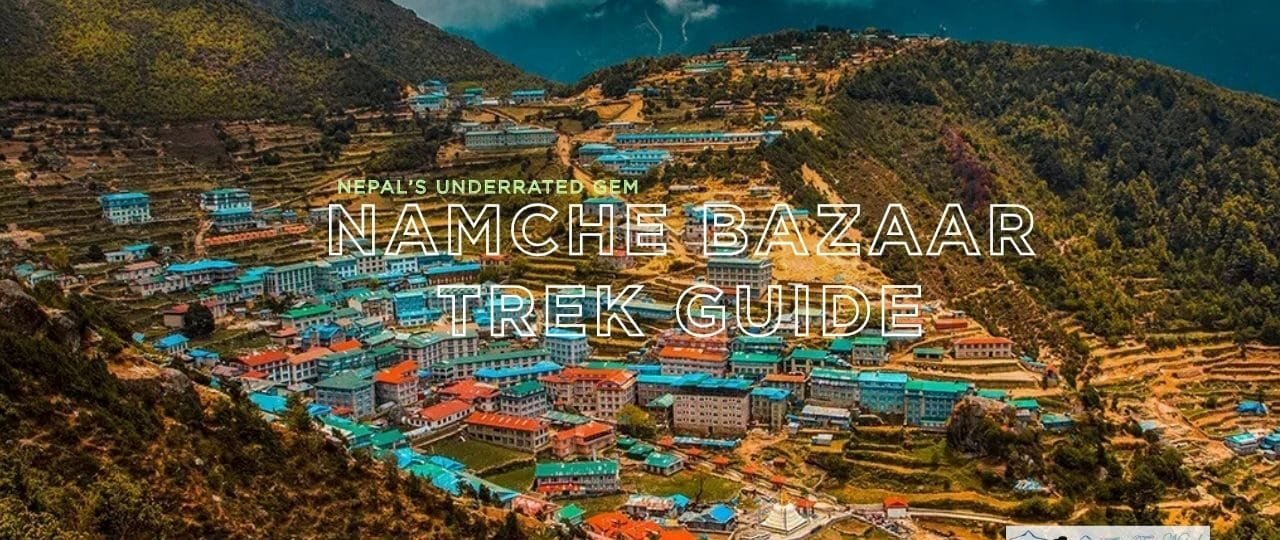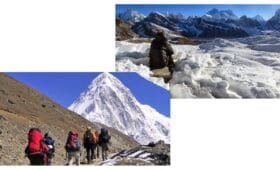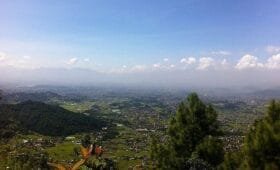The Namche Bazaar Trek is ideal for travelers seeking a short, scenic immersion into the Everest region. Starting from the bustling airstrip of Lukla, this adventure leads you through picturesque valleys and suspension bridges until you reach Namche, the historical Sherpa capital of Khumbu. Although often overshadowed by the classic Everest Base Camp route, the Namche Bazaar Trek offers captivating mountain vistas, vibrant local culture, and an excellent acclimatization opportunity for those with limited days. Many visitors call it a “mini-trek with mega-views,” blending moderate altitude gains with the dynamic atmosphere of Himalayan life.
This extensive Namche Bazaar Trek guide will dissect every aspect of the Trek—from daily distances and route details to cost breakdowns, recommended gear, best seasons, and philanthropic travel opportunities through Volunteers Initiative Nepal (ViN). If you yearn for a moderate trek that still reveals the grandeur of Everest’s foothills, the Namche Bazaar Trek is a prime choice.
Introduction
1. Introduction: Why the Namche Bazaar Trek?
Namche Bazaar sits at about 3,440 meters, a vantage point that provides you glimpses of Mt. Everest (8,849m) and other Himalayan summits—like Lhotse, Nuptse, and Ama Dablam—on clear days. The Namche Bazaar Trek is sometimes described as “Everest in Microcosm,” capturing the region’s essence without requiring you to trek for two weeks. Consequently, it appeals to those who want a taste of Sherpa culture and mid-altitude Himalayan terrain. You can even adapt the trek as a stepping-stone to more ambitious routes, such as the Gokyo Lakes or the entire Base Camp trail.
Statistic: According to local tourism boards, nearly 60,000 visitors land in Lukla annually. However, only a fraction choose a shorter loop culminating in Namche. This smaller footfall ensures you can intimately experience Sherpa traditions and enjoy the panoramic vantage at lower altitudes before deciding to continue deeper into Everest territory.
“I chose the Namche Bazaar Trek for a short Himalayan taste, and it delivered far beyond expectations—stunning vistas, lively Sherpa culture, and enough altitude challenge to make it a real adventure,”
says Alicia, a 32-year-old traveler from Australia.
Overview
2. Cultural & Geographic Backdrop
2.1 Sherpa Heritage
While Kathmandu is Nepal’s political heart, Namche Bazaar has long been its Sherpa capital. Historically, Sherpas migrated from eastern Tibet about 600 years ago. Their culture remains in Tibetan Buddhism, with revered monasteries (gompas) and colorful prayer flags adorning village entryways. Visitors often witness families wearing traditional bhikkhus, herding yaks, or operating teahouses, bridging tradition with modern tourism demands.
2.2 Gateway to Khumbu
The Namche Bazaar Trek occurs in the lower Khumbu region, overshadowed by Himalayan giants. Lukla (~2,840m) is the typical start point, connected to Kathmandu by a ~30-minute flight. From Lukla, the route weaves through farmland, pine forests, and across the Dudh Koshi River before culminating at Namche. Many travelers then use Namche for acclimatization if continuing to EBC or other advanced routes. The scenic synergy of farmland, towering peaks, and communal Sherpa culture shapes the entire experience.
Trek Itinerary
3. Namche Bazaar Trek Itinerary
A standard Namche Bazaar Trek Itinerary might run 5–7 days from Kathmandu, assuming you only intend to reach Namche and perhaps a vantage point like the Everest View Hotel:
Day 1: Fly Kathmandu → Lukla (~2,840m), Trek to Phakding (~2,610m)
~30-minute flight. A gentle ~3–4 hour walk descending to Phakding. Teahouse overnight.
Day 2: Phakding → Namche Bazaar (~3,440m)
~5–6 hours. Cross multiple suspension bridges and pass the Monjo checkpoint for Sagarmatha National Park. A steep climb marks the final approach to Namche.
Day 3: Acclimatization / Exploration Day in Namche
Explore local markets, visit the Sherpa Culture Museum, or trek up to Everest View Hotel (~3,880m) for the morning panorama of Everest, Lhotse, and Ama Dablam.
Day 4: Namche Bazaar → Khumjung (~3,780m) or Surrounding Villages
Optional ~4-hour round trip. Tackle a moderate ridge above Namche. Alternatively, relax in Namche and soak up the local vibe.
Day 5: Return from Namche → Lukla (~2,840m)
~6–7 hours descending. Stay overnight in Lukla’s teahouse.
Day 6: Fly Lukla → Kathmandu
Morning flight. Spare day is recommended if flight disruptions occur.
Namche Bazaar Trek Duration can compress to 4–5 days if skipping an acclimatization day or side expansions. Others might expand the route with a night in Thame or a lower loop near Phakding. Regardless, the core journey remains a short, scenic window into Khumbu’s environment and culture.
Trek Distance
4. Namche Bazaar Trek Distance & Route Breakdown
Namche Bazaar Trek Distance from Lukla to Namche is ~12–15 km, depending on side expansions. While daily hikes from Lukla to Namche average ~5–6 hours, the route’s net altitude gain (~600m) can be felt in the final steep climb. The path’s prime landmarks:
- Lukla: Busy gateway with shops, restaurants, and gear rentals.
- Phakding: Subtropical farmland, comfortable teahouses near Dudh Koshi.
- Monjo: Sagarmatha National Park checkpoint.
- Namche: The epicenter of Sherpa commerce, featuring cafes, bakeries, gear shops, and vantage points.
The Namche Bazaar Trek Route is straightforward, but you can incorporate vintage day hikes around Namche for glimpses of Everest or a foray into the Buddhist monastery in Thame (~3,820m).
Trek Difficulty
5. Understanding Namche Bazaar Trek Difficulty
Namche Bazaar Trek Difficulty is moderate:
- Altitude: Namche is ~3,440m—significant enough to pose a mild altitude sickness risk.
- Daily Hours: ~5–6 hours of trekking daily, especially on the second day to Namche.
- Terrain: Relatively well-maintained trails. A steep final climb near the “Namche Hill” after crossing the Dudh Koshi.
- Acclimatization: One rest day in Namche typically suffices for novices. Seasoned hikers might skip it, though not recommended if continuing onward.
Overall, the trek suits travelers with moderate fitness or novices aiming for a stepping stone to bigger Himalayan ambitions. A slow, steady pace helps handle the cumulative altitude.
Trek Cost
6. Budgeting the Namche Bazaar Trek Cost
Namche Bazaar Trek Costs typically include flights, teahouse lodging, meals, and potential guide/porter expenses. Key breakdown:
Flight to Lukla
~USD 180–200 each way, subject to seasonal fluctuations. Some prefer bus/jeep to Jiri/Phaplu plus multi-day approach, significantly extending the trek.
Accommodation & Meals
Teahouses: ~USD 3–6 per night at lower altitudes, ~USD 5–8 near Namche.
Meals: ~USD 20–30 daily, with prices increasing as altitude rises.
Permits
Namche Bazaar Trek Permits: Sagarmatha National Park entry (~USD 30) + local municipality fee (~USD 20). A TIMS card (~USD 10–20) might apply.
Guide & Porter
A Namche Bazaar Trek Guide can cost ~USD 25–30/day. Porters ~USD 15–20/day.
Misc
There are hot showers (~USD 2–5), Wi-Fi (~USD 2–5), and device charging (~USD 1–2). Souvenirs in Namche can be pricier but varied.
Hence, for a 5–7 day itinerary, a minimal approach might cost ~USD 500–700, plus potential flight tickets. Booking a Namche Bazaar Trek Package might range ~ from USD 700–1,000, covering flights, staff, and partial lodging.
Trek Permits
7. Permits & Requirements: Namche Bazaar Trek Permits
The Namche Bazaar Trek does not require restricted-area permits, but standard regulations apply:
- Sagarmatha National Park Entry: ~USD 30, check or pay at the Monjo checkpoint.
- Local Municipality Fee: ~USD 20 in Lukla or at a checkpoint.
- Though official enforcement can vary, TIMS Card: ~USD 10–20.
Always confirm the current pricing; local rules can shift. Keep your passport and permit slips on your person. If you use an agency or guide, they typically handle these formalities.
Timing / Season
8. Ideal Season: Namche Bazaar Trek Best Time
Namche Bazaar Trek Weather typically aligns with broader Everest region climates:
Autumn (Sept–Nov)
Crisp days ~10–20°C below 3,000m, sub-zero nights near Namche. Minimal rainfall, best mountain clarity. Peak trekking crowds.
Spring (Mar-May)
Blooming rhododendrons, moderate daytime temps. Occasional afternoon clouds or showers.
Winter (Dec–Feb)
There are fewer trekkers and sub-zero nights near Namche, but the route remains open. Crisp, clear mornings often yield epic sunrise views over the Himalayas.
Monsoon (Jun–Aug)
Heavy rains hamper Lukla flights, and slippery trails and cloud-limited vistas exist. Although it is lush farmland, it is not ideal for photography or reliability.
Hence, the Namche Bazaar Trek’s Best Time is typically autumn or spring, which balances stable weather and scenic vistas. Winter suits those comfortable with colder nights and fewer crowds, while monsoon is the least recommended time.
Accommodation
9. Lodging & Amenities: Namche Bazaar Trek Accommodation
Namche Bazaar Trek Accommodation:
Lukla, Phakding
Multiple teahouses, modest private rooms, standard communal dining. Hot shower for a fee.
Namche Bazaar
The region’s hub offers basic teahouses to more comfortable lodges with Wi-Fi, cappuccinos, and gear shops. Prices are higher, but the variety is impressive.
Side expansions
If venturing beyond Namche to villages like Thame or Khumjung, expect teahouses with more spartan amenities.
Meals revolve around dal bhat, noodles, momos, chapati, and Western items like pizza or yak cheese sandwiches. Namche hosts bakeries serving pastries and coffee, a treat at over 3,400m.
Trek Weather
10. Seasonal Weather & Namche Bazaar Trek Weather
Namche Bazaar Trek Altitude (~3,440m) means nights can be chilly year-round, but day temperatures may hover ~10–15°C in autumn or spring. Winter can see sub-zero daily near Namche, though typically still sunny. The monsoon is wet, with frequent cloud cover. Keep a flexible schedule for possible Lukla flight delays or weather-induced route modifications.
Weather Patterns by Season
- Monsoon: Cloudy, rainy, lukewarm.
- Autumn: Crisp, stable, limited rainfall.
- Spring: Warmer, with some showers and vibrant flora.
- Winter: Clear but cold, less crowded.
FAQs
11. Seven Frequently Asked Questions
How long is the Namche Bazaar Trek Duration?
Typically, 5–7 days from Kathmandu, including flights, 2–3 trekking days each way, and a rest day in Namche.
What is the Namche Bazaar Trek Distance?
Lukla to Namche is ~12–15 km, and if you return directly, it will take 2 days uphill and ~1–1.5 days downhill.
How difficult is the Namche Bazaar Trek Difficulty?
Moderate. There is a daily ~5–6 hours of hiking, with a notable altitude of ~3,440m at Namche. This is manageable for beginners with decent fitness.
How much does the Namche Bazaar Trek Cost?
~USD 500–700 on a minimal approach (teahouse style, 5–7 days) plus Lukla flights. A Namche Bazaar Trek Package might run ~USD 700–1,000.
What permits do I need?
Namche Bazaar Trek Permits: Entry to Sagarmatha National Park (~USD 30), local municipality (~USD 20), and TIMS card (~USD 10–20).
Which is the Namche Bazaar Trek Best Time?
Autumn (Sept–Nov) or spring (Mar–May) for stable weather, scenic cland arity, and moderate day temps.
Do I need a Namche Bazaar Trek Guide?
Optional. The route is straightforward, but a guide (~USD 25–30/day) enriches cultural insight and ensures lodging, safety, and local support.
Additional Tips
12. Additional Namche Bazaar Trek Tips & Packing List
12.1 Packing Essentials
A typical Namche Bazaar Trek Packing List includes:
- Layers: Thermal base, fleece or down jacket, waterproof outer shell.
- Footwear: Well-worn trekking boots and extra socks.
- Accessories: Sunglasses, gloves, beanie, buff or scarf.
- Gear: Daypack (25–35L), trekking poles, water purification tablets, personal first-aid kit, headlamp, quick-dry towel.
- Documents: Permits, passport copies, travel insurance covering ~4,000m altitude.
12.2 Plan for Altitude
The elevation of the Namche Bazaar Trekion is “only” ~3,440m; altitude sickness can still occur if you feel unwell, a. Ascend slowly, hydrate well, and rest an extra day at Nam. If you plan to continue to EBC, plan further acclimatization.
12.3 Minimizing Environmental Impact
- Respect Culture: Always greet with “Namaste,” ask before photographing locals or inside monasteries.
- Carry Reusable Bottles: Purify or purchase boiled water. Avoid single-use plastic.
- Pack Out Trash: Use designated bins if provided.
Reviews
13. Namche Bazaar Trek Reviews & Real Stories
Many Namche Bazaar Trek Reviews emphasize:
- Cultural Immersion: The trek fosters deeper Sherpa interactions compared to a hurried helicopter tour or EBC direct approach.
- Mountain Views: Everest, Lhotse, Ama Dablam glimpses from vantage points around Namche (Everest View Hotel, Syangboche).
- Market Vibe: Namche hosts a weekend market, cafes with Wi-Fi, and local cheese shops—an unexpected modern swirl at 3,440m.
“I had only one week in Nepal. The Namche Bazaar Trek was perfect: short flight, short trek, but epic mountain vistas and immersive Sherpa culture. Even though altitude was new to me, the pace felt balanced,”
says Mark, a 39-year-old from Canada.
Conclusion
From Lukla’s busy runway to the bustling lanes of Namche Bazaar, the Namche Bazaar Trek merges moderate-level hiking, stellar Himalayan scenery, and daily Sherpa encounters. With a maximum altitude of ~3,440m, it offers a comfortable introduction to high-altitude trekking for novices or a side loop for experienced travelers short on time. Moreover, the synergy of local culture—bakeries and gear shops in Namche—brings unexpected comfort mid-trek.
Charity trekking and travel tours
Double Impact: Volunteers Initiative Nepal
Volunteers Initiative Nepal (ViN) organizes charity trekking and travel tours so each footstep helps empower remote Nepali communities. By joining the Namche Bazaar Trek with ViN, you create a “double impact”:
- Share: Encourage friends, families, and social media networks to adopt philanthropic trekking, forging a synergy of adventure and positive change.
- Volunteer: Dedicate time to local projects (education, environment, or health) near Lukla or Namche.
- Intern: Merge academic or professional objectives with real-world rural development.
- Donate: Even minimal funding fosters local schooling, community health, or infrastructure improvements.
Namaste—and may your steps toward Namche Bazaar unify personal growth with communal uplift, forging a future where tourism fosters empowerment for Himalayan families.
Practical Guidance
Extended Practical Guidance & Final Inspiration
1. Seasonal Breakdown & Weather
- Autumn (Sept–Nov): Crisp is stable and recommended for novices: crisp days and star-filled nights.
- Spring (Mar-May): Warmer, rhododendron blossoms, potential haze in afternoons.
- Winter (Dec–Feb): Clear skies, minimal crowds, cold nights near 0°C or below. The route remains open.
- Monsoon (Jun–Aug): Inconsistent Lukla flights, heavy rains, limited panoramas, but lush farmland.
2. If You Have More Days
- Everest Base Camp: Continue from Namche to Tengboche and beyond for a 2-week EBC trip.
- Thame: A quiet Sherpa valley, less touristy, a short side trip from Namche.
- Khumjung: Another day hike exploring the Edmund Hillary School and a revered monastery said to house a yeti scalp.
3. Potential Obstacles
- Flight Delays: Lukla is notorious for weather-based flight cancellations. Build in a day or two buffer.
- Altitude: Some novices feel mild AMS near Namche. Rest an extra day, and hydrate well.
- Teahouse Overcrowding: In peak autumn or spring, arrive early to secure rooms.
4. After the Trek
- Explore Kathmandu: UNESCO heritage sites, Thamel’s shopping and dining.
- Volunteer: With ViN’s short community stints, bridging trekking with local empowerment.
- Relax: Lakeside in Pokhara or short cultural tours around the valley to reflect on your Himalayan experience.
By merging the Namche Bazaar Trek Route with philanthropic synergy, your short Himalayan foray becomes more than scenic images. The route’s synergy of moderate trekking, dynamic cultural immersion, and philanthropic synergy fosters a powerful, lasting memory. Embrace the “double impact” approach: from vantage points near Namche, you help shape a brighter tomorrow for Nepal’s remote communities—turning your adventure into a collective triumph.
Final Summation
The Namche Bazaar Trek is a convenient, scenic gateway to Everest’s wonders, bridging farmland below Lukla to a bustling Sherpa capital. Crisp air, sweeping panoramas, and the chance to engage with local traditions highlight each day. Meanwhile, partnering with Volunteers Initiative Nepal infuses your journey with a greater purpose—transforming a short trek into a stepping stone for community-driven change in the Himalayas. Let the synergy of cultural authenticity and natural splendor shape your trek experience, forging cherished connections and a path that resonates beyond the mountains
.




